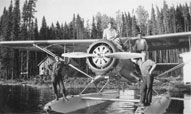Location of Hank Langstaff’s bush camps in Western Ontario.
From the mid-1870s to the early 1920s, the quest for furs, then for minerals, brought Europeans to the area. In the summer of 1925, two brothers, Lorne and Ray Howey, discovered gold under the roots of an upturned tree. This event triggered the last great gold rush in North America, the birth of commercial bush flying in Canada, and the founding of the town of Red Lake.
More than 3,000 people converged on Red Lake at the height of the Gold Rush of 1926. They traveled by dog team or by foot on the frozen rivers and lakes, over the 180-mile gold rush trail. In spring, they used canoes or small boats, and before long, airplanes. Eventually the bush plane came to dominate travel to the goldfields. In 1936, Howey Bay, in the heart of Red Lake, was the busiest airport in the world, as aircraft of all shapes and sizes, on floats or skis, transported freight and passengers in and out of the area at 15-minute intervals.

